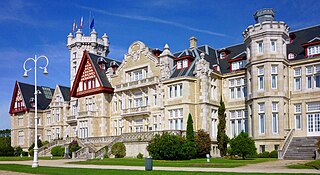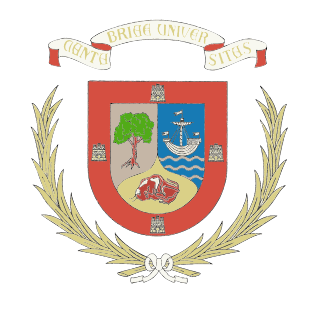
Cantabria is an autonomous community and province in northern Spain with Santander as its capital city. It is called a comunidad histórica, a historic community, in its current Statute of Autonomy. It is bordered on the east by the Basque autonomous community, on the south by Castile and León, on the west by the Principality of Asturias, and on the north by the Cantabrian Sea.

Santander is the capital of the autonomous community of Cantabria, Spain. It has a population of 172,000 (2017). It is a port city located in the northern coast of the Iberian Peninsula, facing the Cantabrian Sea.

Laredo is a town in the autonomous community of Cantabria, Spain. According to the 2008 census (INE), the municipality has a population of 12,648 inhabitants. In addition to Laredo, the municipality includes the villages of La Arenosa, El Callejo, Las Cárcobas, Las Casillas, La Pesquera, Tarrueza and Villante. Except from the last two, the other villages had been physically integrated into Laredo.

Cantabrian cuisine is the cuisine from Cantabria, an autonomous community in northern Spain. It includes seafood from the Cantabrian Sea, salmon and trout from the upper basins of the rivers, vegetables and dairy products from the valleys, and veal and game from the Cantabrian mountains.

Club Balonmano Cantabria was a team of handball based in Santander, Cantabria. CB Cantabria was not registered in any handball league after 2008.

University of Cantabria (UC), is a public university located in Santander, Torrelavega and Comillas in Cantabria, Spain. It was founded in 1972 and is organized in 15 schools and colleges.
The Regionalist Party of Cantabria is the second oldest political party in the Spanish Autonomous Community of Cantabria. The PRC originated in the Association in Defense of the Interests of Cantabria (ADIC), founded on 14 May 1976, with the objective of promoting Cantabrian autonomy.
The Asturias autonomous football team is the regional football team for Asturias. They are not affiliated with FIFA or UEFA, because it is represented internationally by the Spain national football team. The team only plays friendlies.

The Cantabria autonomous football team is the regional football team for Cantabria, Spain. They are not affiliated with FIFA or UEFA and therefore are only allowed to play friendly matches.

Rayo Cantabria, formerly known as Real Racing Club de Santander "B" is the reserve team of Racing de Santander, a Spanish football team based in Santander, in the autonomous community of Cantabria.

The Federation of Regional Organizations of Radio and Television is the association of the public broadcasting networks from 12 autonomous communities of Spain. It was created on 5 April 1989.

Cave del Valle, locally also known as La Viejarrona, is located near El Cerro Village in the municipality of Rasines in Cantabria, northern Spain. The cave is the source of the Silencio River, a tributary of the Rio Ruahermosa, which in turn is a tributary of the Asón River. Notable for its prehistoric, but particularly for its speleologic significance as it is recognized as one of the longest cavities in the world. The site is very popular among cavers, who have explored a total of over 60 km (37.28 mi) so far.
"Himno a la Montaña", or "Himno de Cantabria", is the official anthem of the Spanish autonomous community of Cantabria. It was composed in 1926 by Juan Guerrero Urresti at the behest of the then Provincial Council of Santander, and subsequent arrangements were made by José del Río Sainz, establishing it as the region's official anthem.

The 2011 Cantabrian regional election was held on Sunday, 22 May 2011, to elect the 8th Parliament of the autonomous community of Cantabria. All 39 seats in the Parliament were up for election. The election was held simultaneously with regional elections in 12 other autonomous communities and local elections all throughout Spain.

The 2015 Cantabrian regional election was held on Sunday, 24 May 2015, to elect the 9th Parliament of the autonomous community of Cantabria. All 35 seats in the Parliament were up for election. The election was held simultaneously with regional elections in 12 other autonomous communities and local elections all throughout Spain.

The 1983 Cantabrian regional election was held on Sunday, 8 May 1983, to elect the 1st Regional Assembly of the autonomous community of Cantabria. All 35 seats in the Regional Assembly were up for election. The election was held simultaneously with regional elections in twelve other autonomous communities and local elections all throughout Spain.

The 2019 Cantabrian regional election was held on Sunday, 26 May 2019, to elect the 10th Parliament of the autonomous community of Cantabria. All 35 seats in the Parliament were up for election. The election was held simultaneously with regional elections in eleven other autonomous communities and local elections all throughout Spain, as well as the 2019 European Parliament election.

The 2023 Cantabrian regional election was held on Sunday, 28 May 2023, to elect the 11th Parliament of the autonomous community of Cantabria. All 35 seats in the Parliament were up for election. The election was held simultaneously with regional elections in eleven other autonomous communities and local elections all throughout Spain.

















